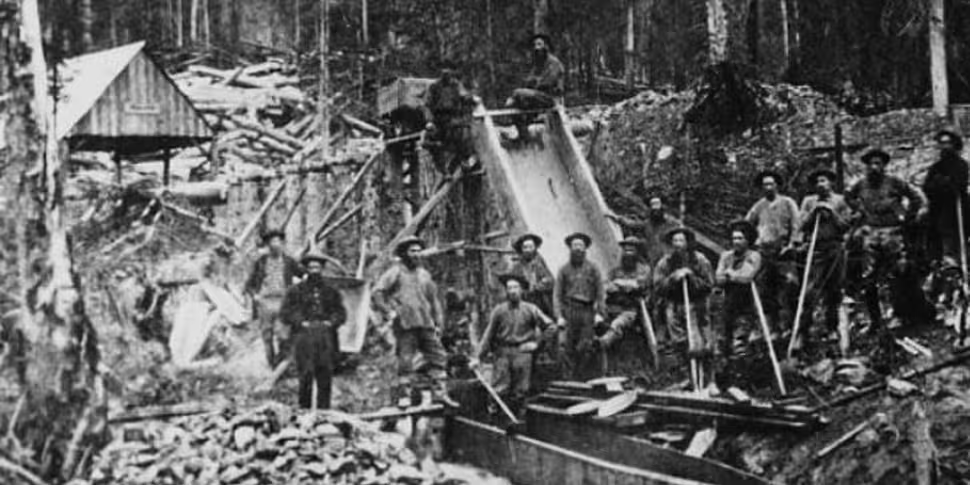For many of us, digging for gold is surely something we’re most familiar with from books and films set in the Old West. It conjures up images of huge amounts of people descending on areas where gold had been discovered, hoping they would strike it lucky and uncover a vast fortune.
Modern gold digging is, as you might expect, a very different matter altogether. On Moncrieff today, Sean will be talking with Steve Boogan - author of ‘Gold Fever: One Man's Adventures on the Trail of the Gold Rush’ - on the subject of digging for gold in the 21st century, as well as the great 19th century Gold Rush. Tune in from 2pm, and listen live at newstalk.com
The most iconic and famous Gold Rush, the one that helped define what mot of us associate with those words, took place in California in 1848. As you might expect, it had modest, unassuming beginnings.
In January of that year - only weeks before the transfer of California into US control, having been Mexican territory before the signing of the Treaty of Guadalupe Hidalgo - James Wilson Marshall, a foreman working under pioneer John Sutter in the colony of Nueva Helvetia (New Switzerland, which later grew into the city of Sacramento) discovered metal flakes in a river at the base of the Sierra Nevada Mountains.
Sutter and Marshall performed some rudimentary tests on the metal, and it turned out Mr Marshall had indeed found gold. The Sutter’s Mill discovery was not, however, something Mr Sutter wanted to shout about from the rooftops. In fact, it was decided to keep the find quiet, as Sutter had plans to further develop the land, and a rush for gold was the last thing he needed. Unfortunately, word did get out, and the rush did have a huge impact on his life, with much of his land destroyed and Sutter himself ending up bankrupt.
Gold! Gold!
Rumours of the discovery spread. Famously, a businessman and newspaper owner named Samuel Brannan paraded through the streets of San Francisco In March 1848 with gold found at Sutter’s Mill, announcing “Gold! Gold! Gold from the American River!”. Brannan, incidentally, would become one of the biggest beneficiaries of the Gold Rush when he set up businesses selling prospecting equipment at often massive mark-ups. While most of the thousands who rushed to California would not make their fortune through gold - the lucky few aside - it was some clever entrepreneurs like Brannan who really benefited from ‘Gold Fever’, making in some cases millions of dollars thanks to the tens of thousands of prospectors who settled in the area.

Sluice for separation of gold from dirt with water
Word spread steadily at first, with thousands of migrants showing up, often from areas accessible by boat (from as far afield as China - thousands of Chinese migrants would settle in California). Despite some initial skepticism over the reports from California, especially on the East Coast of the US, those suspicions soon evaporated. As President James K Polk announced in his annual message in December 1948, “recent discoveries render it probable that these mines are more extensive and valuable than was anticipated. The accounts of the abundance of gold in that territory are of such an extraordinary character as would scarcely command belief were they not corroborated by the authentic reports of officers in the public service who have visited the mineral district and derived the facts which they detail from personal observation.”
Forty-niners
The Gold Rush reached something of a fever pitch in 1849, as tens of thousands of migrants - eventually dubbed ‘forty-niners’ - made the often perilous trip to California. The population predictably exploded - it’s estimated, for example, that San Francisco's population grew from around 800 people in 1848 to anywhere between 50,000 and 100,000 people in 1849. People came from across the US, but also from around the world - which would lead to racial tension when supplies started running dry and a high monthly ‘foreign miner’s tax’ imposed on international migrants. While the population boom led to increased economic activity, it also led to the growth of crime, gambling, prostitution and more in the region.
Inevitably, the Gold Rush did not last long in the general scheme of things. The amount of gold discovered in the ground peaked in 1852. The following year, the process of hydraulic mining drastically decreased the need for traditional labour and panning, although also had a major impact on the Californian landscape. As well as the environmental impacts, the Gold Rush had a catastrophic effect on Native American populations. Their land was polluted and they were subjected to new diseases that arrived along with the settlers. Most disturbingly, they were very often victims of violence and massacres at the hands of some of the same settlers.
The effects of the Gold Rush were far reaching, even stimulating the economy outside California and the US due to demand for food and materials. But California itself was undoubtedly most affected by the Gold Rush, for better and worse. It retains its reputation as The Golden State, more than 160 years after tens of thousands came looking for gold in the hills and rivers surrounding Sutter’s Mill.









